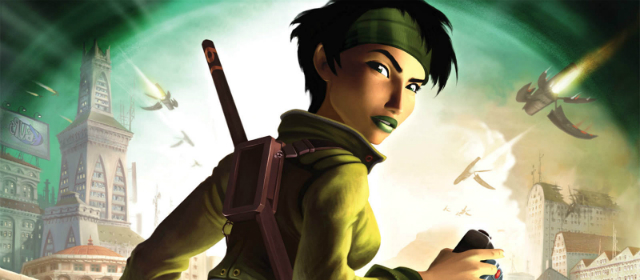Name: Jade
Game: Beyond Good & Evil (2003)
Species: Human
In her own words: “Who do you think you are? Did you think you’d actually be able to make a difference?”
Given that video game narratives are still in the process of emerging from what has been a long, spotty, embarrassing adolescence, it seems churlish to pick on one of the medium’s better offerings and complain at length about its only major flaw.
Since I happen to be a big churl, that’s exactly what I’m going to do with Beyond Good & Evil, Michel Ancel’s beloved 2003 opus about a green-lipped photojournalist and her tireless quest for truth and justice.
Beyond Good & Evil is the story of Hillys, a peaceful mining planet populated in fairly equal measure by humans, animals and everything in between, i.e. anthropomorphic sharks, rhinos, walruses and goats. The story begins as Hillys endures yet another attack from the DomZ, a hostile alien race who regularly abduct its citizens for reasons unknown. Assigned to protect the planet are the Alpha Sections, hulking armoured man-mountains led by master of propaganda General Kehck.
The protagonist is Jade, who lives with her adoptive uncle Pey’j (a pig, obviously) and an adorable collection of orphans in an idyllic lighthouse. When looking for work to help resolve the family’s cash-flow problem, Jade is recruited by the shady “Iris Network”, who claim that the Alpha Sections are in fact in league with the DomZ and are thus complicit in the Hillyan’s plight. As Jade, the player must use her camera and sneaking skills to infiltrate the Alpha Section’s various bases of operations and expose their crimes to the population.
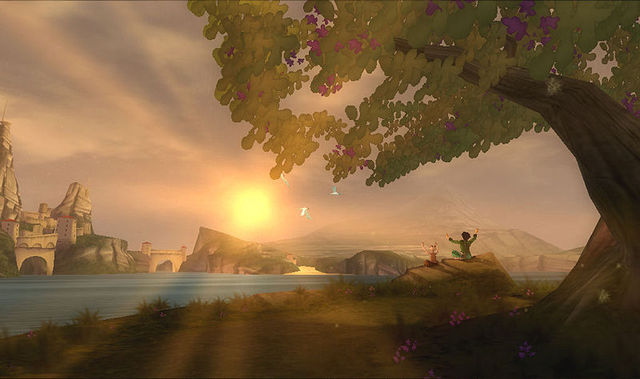
So far, so very, very good. Like so many video game heroes, Jade defeats her enemies by pointing and shooting, but unlike her peers, her weapon of choice is a camera, not a gun. Her pictures allow the Hillyans to make up their own minds, meaning Jade never has to turn vigilante and take bloody revenge on the bad guys.
“Jade, she doesn’t have guns, things like that,” explains Ancel. “She’s got a camera and she just wants to understand the world. When there is a war, something like that, we just want to understand what is going to happen? Why? She doesn’t want to kill the bad guys, she wants to understand. Jade is very important because she’s more than just a character, she is a way of approaching these problems.”
The decision to make Jade an agent for truth rather than destruction means that the ludonarrative dissonance that so often plagues action-adventure games is absent from Beyond Good & Evil. The player does not have to “forget” violence on Jade’s part as they watch cutscenes that depict an otherwise likable character, because she only uses violence as a last resort, preferring instead to avoid conflict and sneak around trouble when she can. She only draws her Dai-Jo, or fighting stick, when it’s unavoidable.
Small but effective narrative touches throughout the game reaffirm the pervasive effect Jade’s revelations are having on the population. Jade can subscribe to Iris’ reports (along with the “Hillyan News”, which provides Alpha Sections’ propaganda), complete not only with Jade’s findings but also the exact photographs the player took on the missions in question. As Jade wanders the Hillyan streets, she starts to overhear murmurs of dissent among the population as the revelations grow more dramatic.
In this way, Beyond Good & Evil quietly, and subtly, re-enforces the sense that Jade is saving her planet in the most just and democratic way possible; by using non-violent methods to allow a stricken people to make up their own minds.
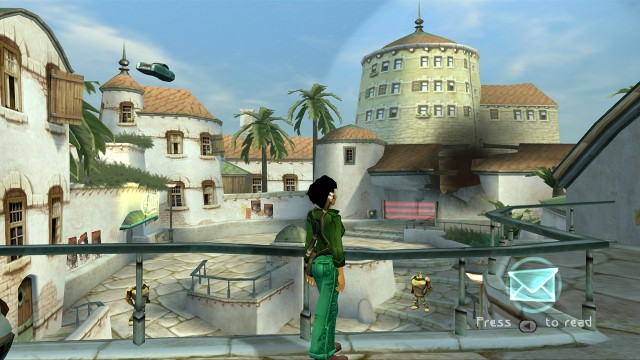
More importantly, the photo-based gameplay makes Jade an unusually easy character for players to identify with because although she can handle herself in a fight if needs be, her greatest triumphs would not be beyond the reach of an ordinary person. She has no unusual abilities, she’s not superhuman and she hasn’t had any special training. Instead, she’s patient, persistent, fair and sensible, agreeing to undertake Iris’ first mission only to satisfy her own doubts in both Iris’ and Alpha’s trustworthiness. Her refusal to even make up her own mind until she’s gathered sufficient evidence, let alone try and convince anyone else, shows the kind of rational mind we rarely see in the hyperbole-drenched absolutist moral landscapes of most video games.
This is not the only thing that makes her a believable heroine. Her motivation – to protect her loved ones and her home – is one players can all identify with, which is more than can be said for those of the rage-driven revenge killers, humorless moralisers and cocksure adventurers who we’re usually asked to portray in games. Moreover, her characterisation is understated, punctuated by gentle idiosyncrasies (green lipstick, bacon jokes) rather than an outrageous personality, self-conscious quirkiness or irrelevant sexualisation.
Indeed, despite living on an alien planet and having a pig for an uncle, Jade’s arguably gaming’s most relatable protagonist.
Which is why the revelation in the game’s final hour that she’s actually a mysterious entity regarded by the DomZ’ High Priest as a source of his power is such a major narrative misstep.
Firstly, aside from a couple of brief visions near the beginning of the game and the codename she chooses for herself (“Shauni”, which the High Priest later refers to her as), there’s nothing in the way of foreshadowing to tie this plot development into the rest of the game. A good plot twist, as BioShock and Deadly Premonition have shown us, should illuminate everything that’s gone before and make a second playthrough utterly different (in a narrative sense) to the first.
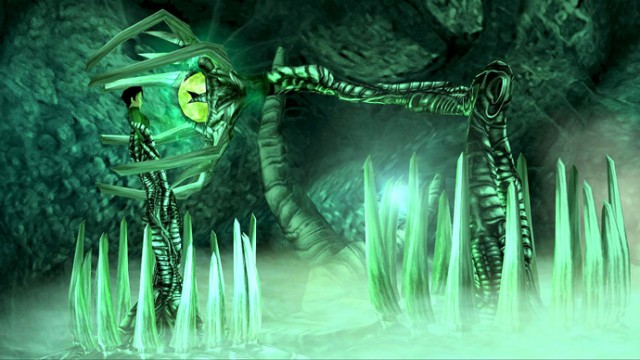
Beyond Good & Evil’s twist does neither of these things, it merely confuses plot details that previously made sense and undermines the narrative power of Jade’s apparent normality in relation to the world she’s trying to save.
It’s worth saying at this point that this (and the post-credits cliffhanger that sees Pey’j struggle with a DomZ-like growth on his arm) will presumably be explained in the sequel, which Beyond Good & Evil’s fans have now been awaiting a decade for. This is cause for optimism but it doesn’t resolve the incongruity of the original game’s left-field ending. As important to the wider Beyond Good & Evil mythos Jade’s “real” identity may turn out to be, it has no place in a story as otherwise small-scale, focused and emotionally familiar as the original game.
If Jade’s heritage was always meant to come into play in the sequel, then for the sake of coherence, perhaps it should have been left out of the original game altogether. It’s entirely possible that, as in The Empire Strikes Back, a second volume revelation based on strong narrative foundations built in the first would have had an enormous impact.
At the end of the first game, however, it’s only one step up from a Deus Ex Machina, raising more questions than it answers. If Jade’s not human, then who are the “parents” whose “courage and generosity” Pey’j claims Jade has inherited? Why does Jade have a human body? How does this relate to the growth on Pey’j’s arm?
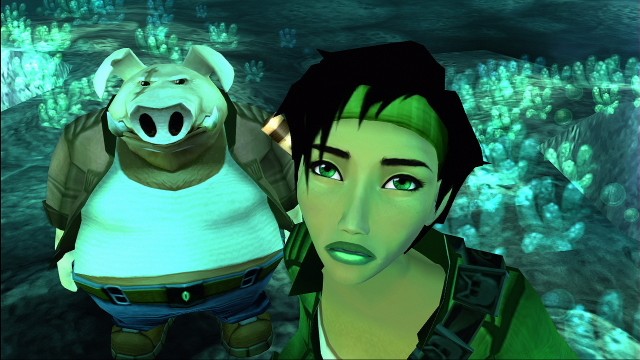
Further to this, there simply isn’t enough detail offered to the player throughout the game as to what the DomZ are, or how they operate, for the revelation to have any meaning. Jade learns of her true identity after unwittingly resurrecting Pey’j, but because that’s also the first the player learns of such supernatural powers on the part of the DomZ (or indeed within the entire Beyond Good & Evil universe), they have to be informed of the connection rather than make it themselves, so the revelation falls flat. Up until that point in the game, the DomZ have been depicted as straightforward migratory parasites, so there’s nothing that the player can deduce or even guess about Jade once they learn who she really is.
The revelation is meaningless, then, but more problematically it undermines the good work the game has done in making the player identify with Jade and her struggle up until that point. The game’s conclusion is an admittedly lovely sequence in the throne room of the DomZ priest in which the captured Hillyans are freed by Jade’s power, floating down from their sarcophagi as Jade levitates, radiating light.
This may be beautiful, but it has little to do with the hard work the player has done informing the Hillyans of the Alpha Sections’ deception. Leaving aside the necessary gameplay loopholes (Jade needs to undertake missions in order to earn the pearls she needs to find and fix the spaceship that will take her to the DomZ base), it implies that Jade needn’t actually have gone to the trouble of exposing the Alpha Sections at all if she had the ability to rescue the captured so easily.
Her powers turn her quickly from a relatable protagonist into an untouchable messiah, and too late in the game for the player to be able to get to know her again. It’s bizarrely disappointing to learn that after 8 hours thinking they’re controlling an ordinary person doing extraordinary things, they’ve actually been controlling a superhero all along. To paraphrase a recent game about a character arc, it turns out that in Beyond Good & Evil, the extraordinary is after all not in what we do, but who we are.
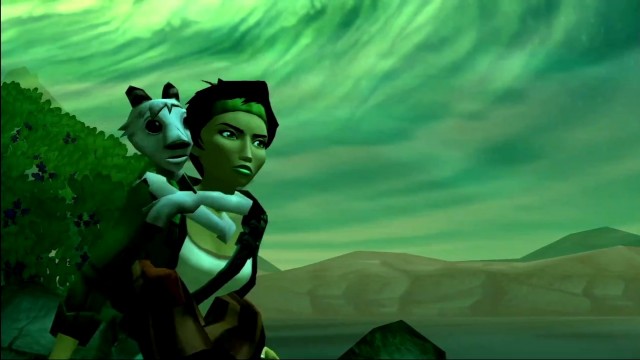
There are two things that future game developers can learn from Beyond Good & Evil’s flawed ending. The first is to understand the technical limitations of the project early, and work to them. In a recent interview (about Rayman Origins), Ancel reveals that he’d originally conceived Beyond Good & Evil as having a far wider scope:
“The first Beyond Good & Evil, when I sent the technical document to Sony, it was the time of the Emotion Engine on the PlayStation 2. We had the feeling that we could do whatever we wanted. We sent them the document, it was about planets, going from planet to planet, towns to towns and all these things. But in the end, what we were really about to do was far less than what we wanted.”
Jade’s identity and its relationship to ancient powers and distant galaxies belongs to a larger game than Beyond Good & Evil, which until the 11th hour is a story of a small island community. Unlike Mass Effect, which Ancel name-checks in that interview, Beyond Good & Evil’s focus is on the effect peril has on the day-to-day lives of ordinary people, not on an entire galaxy. A larger game with more locales could have given Ubisoft Montpellier space to lay the groundwork for the ultimate revelation, but within Beyond Good & Evil’s detailed exploration of a small place, there just isn’t room.
The second is a universal rule to which all narrative design in games should adhere, and that is: tell the story through the game. The reason Beyond Good & Evil is so adored by so many is that, for the most part, it places the player in a delightful world, full of personality and heart, and lets them explore it for themselves, talking to its inhabitants, wandering through its friendly streets and photographing its beautiful wildlife. They save it (or so they think) by giving its populace – many of whom they’ve got to know as individuals – information they’ve been able to find through exploration and discovery. It’s through their own actions that they build a coherent and long-lasting picture of the world they’re in.
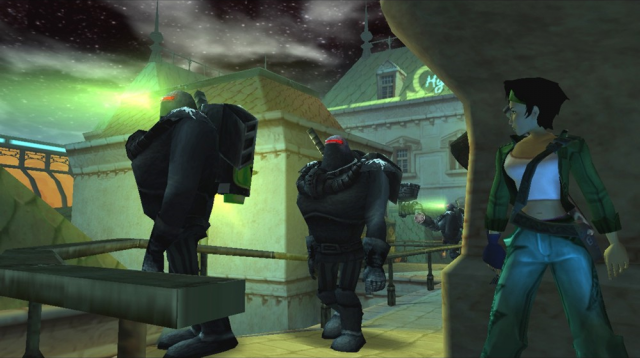
So when control is removed and they’re told that the truth behind the events is something they’ve had no involvement in, it’s very distancing. Jade’s identity is revealed through cutscenes, the player experiences no difference in her abilities and controlling her feels exactly the same. The all-important connection they feel to her is lost when they learn that alongside her “true” power, the achievements she’s managed with them in control are insignificant.
Of course, all is not lost. It takes more than a misjudged ending to ruin a game of Beyond Good & Evil’s calibre, more than a final act about-face to undo hours of effective gameplay-based character development and world-building. The game is still a triumph, but it succeeds despite its ending, not because of it.
The sequel has its work cut out for it. It must get made, for a start, and avoid the pitfalls and feature creep that a protracted development cycle can so often bring. It needs to retain the charm of its predecessor while making the most of the technology that powers it. But most of all, it must mend the fracture that Beyond Good & Evil’s ending made in its own mythos, rejoining who Jade is with what she – and the player – can do.


